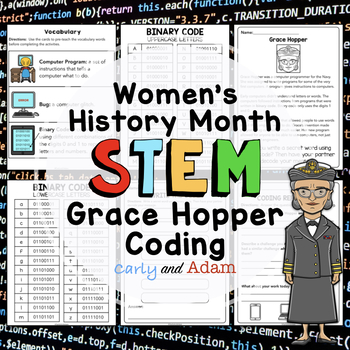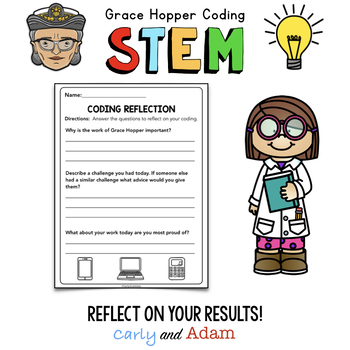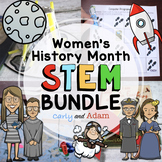Grace Hopper Queen of Computer Code Unplugged Coding Activity
- PDF
- Easel Activity
What educators are saying
Also included in
- Integrate STEM and Social Students during Women's History Month in your makerspace, STEM Club, Library, and 1st Grade through 5th Grade classroom! Teach students that anyone can be successful in STEM and important leaders in our world regardless of gender.Build a lunar lander to help Apollo AstronauPrice $10.00Original Price $13.00Save $3.00
- Integrate STEM and Literacy in your classroom all year with READ ALOUD STEM Volume One! Everything you need to be the master STEM Teacher at your school! Awaken imagination and creativity all year. Students learn coding, engineering, explore real-world problems, learn about STEM role models, pioneerPrice $100.00Original Price $158.50Save $58.50
Description
Integrate History and Coding with a Grace Hopper Unplugged Coding Women's History Month STEM Activity in your makerspace, STEM Club, library, and 1st Grade through 5th Grade classroom!
This Grace Hopper Queen of Computer Code Challenge is a fun and unique way to engage your students during Women's History Month and introduce them to binary coding.
Grace Hopper was one of the first female computer programmers. She created a program that allowed people to use words to tell the computer what to do. Her new program allowed for anyone to be able to use computers, not just scientists and engineers. Teach students that anyone can be a scientist regardless of gender.
Students begin the activity by reading about Grace Hopper. We included our own mini reading passage, and you can also use the read-aloud Grace Hopper Queen of Computer Code by Laurie Wallmark as a bonus!
Students work together to create binary codes to write and decode words. Every activity and solution is unique as students create their own code. This is a fun activity to help reinforce vocabulary words and spelling words.
After they have completed their activity, there is time for reflection on what worked and what didn't.
This activity is completely unplugged, and no robots are required. Perfect activity for Hour of Code.
Amazing resource for STEM club, coding club, STEM teachers, technology teachers, elementary librarians, parents who love hands-on learning, and elementary teachers who want to create a hands-on educational environment in their classroom!
Includes:
- Teacher Instructions
- Student Instructions
- Student Coding Activity
- Student Reflection Sheets
- Grace Hopper Mini Reading Passage
- TpT Digital Version for Distance Learning with Google Classroom
Digital Activity:
To use Easel for Distance Learning, select "Open in Easel" on this listing.








